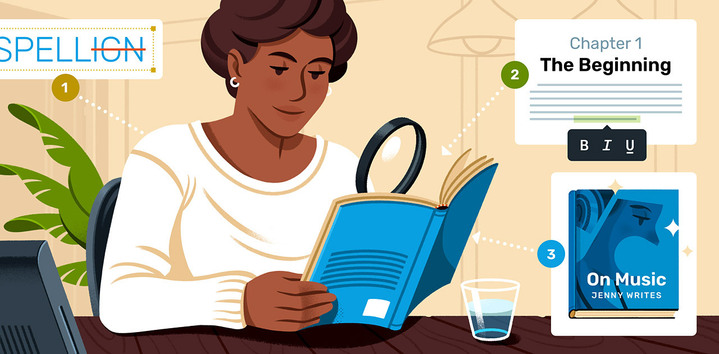What is Copy Editing?
Copy editing is the act of fine-tuning a book’s text, otherwise known as the ‘copy.’ A copy edit will generally address grammatical or punctuation errors, incorrect facts, anomalies, inconsistencies and glaring typos. Overall, The purpose of copy editing is to ensure that the language supports the writer’s intent — while also creating the most readable version of their book.
Professional copy editors can make sure your manuscript isn’t riddled with bad grammar, spelling mistakes, or glaring inconsistencies. They won’t enter into big-picture issues such as characterization, plot or pacing; instead, they will go through the manuscript line by line and focus on all the little things you might not have thought about. They’ll catch scenes in which your antagonist is wearing sunglasses and spectacles at the same time. They’ll save your tone and style from unintentionally wild shifts between sections. They’ll pull your book together page by page.
But where can you find a meticulous copy editor with the right experience to take your manuscript to the next level?
Look no further, here are the professionals who can help
Joe P.
Fast. Friendly. Experienced. Thorough. I'm here to help you be your best. Sample edits available.
view profileAndrew L.
Hugely experienced editor, non-fiction/ fiction: reads, pitching, proposals, edits, indexes, a link between authors and publication.
view profileRachel K.
After editing hundreds of books for publishers such as W. W. Norton and Crooked Lane, I can't wait to help you with your masterpiece!
view profileJonathan S.
I've spent 18 years editing debuts and bestsellers across genres, traditional and self-published. Agent/publisher queries. Caring, diligent.
view profileLouise S.
A detail-oriented proofreader with experience in basic copyediting. I specialize in fiction, creative non-fiction, and memoirs.
view profileThe different standards of copy editing
Individual copy editors consult a range of manuals for copy editing. These include The Chicago Manual of Style, The Associated Press Stylebook, and Words into Type. Editors also set a specific dictionary as the authority, such as Merriam-Webster’s Collegiate Dictionary. Using these references as guides, copy editors will correct errors and fix inconsistencies in details like number treatment (should it be a numeral or spelled out?), compound words (should it be open, closed, or hyphenated?), and punctuation (should it be a comma or semicolon?). For example, on this page, we’ve decided to write “copy editing” and “copy editor” without hyphenation. And then we’ve had a copy editor take a look at it to make sure we had done so consistently.
To keep track of the styles in use in a single manuscript, copy editors create a style sheet as they edit. A novel’s style sheet should include notes on typography, punctuation, numbers, and spellings; a list of characters, real people, and places; and a timeline of events. A detailed style sheet is an organized way for an editor to maintain consistency and communicate a manuscript’s style to the author and future proofreaders.
What does a copy editor do (and not do)?
A professional copy editor will thoroughly work through your text, making changes that perfect your manuscript by improving accuracy, grammar, punctuation, and spelling, and eliminating redundancies in your text. Related to this, a good editor will also ensure consistency of style, checking that your own personal style remains intact through smaller details such as hyphenation and capitalization.
One of the overall improvements that a copy editor can make to your manuscript is strengthening the prose throughout. They will substitute weak words, phrases, and sentences with powerful alternatives, often even restructuring sentences for improved clarity. Once your manuscript has been copy edited, it will be more efficient, accurate, and focused on your voice. In fact, your manuscript will be in such good shape that it will be ready to be typeset and then reviewed by a proofreader.
While the purview of a copy editor will vary from contract to contract, most copy editors will not handle ‘big picture’ issues such as characterization, plot, or structure. That would be the responsibility of a developmental (or content) editor. Copy editing takes a much closer view of a manuscript — focusing on individual sentences and paragraphs.
What is the difference between line editing and copy editing?
“Line editing” is a term we’ve chosen not to use in our editing services definitions. This is because its meaning can vary wildly depending on whether you’re in the UK — where it’s akin to proofreading — or in North America — where it’s an intermediary step between developmental and copy editing.
In its US definition, line editing addresses the creative content of a manuscript, rather than mechanics like punctuation, grammar, factual correctness, and consistency. The line editor looks at the author’s use of language and offers advice to improve the readability of a manuscript. They will address issues like baggy dialogue, tonal inconsistencies, run-on sentences, and other such tics that may affect the reading experience.
Most copy editors on Reedsy are also trained in line editing, and will seek to correct both creative content and mechanical issues in their editing pass. In other words, most copy editors will both line edit and copy edit, which is why we’ve chosen to skip this “step” in our definitions, and recommend authors first hire a developmental editor, then a copy editor, and finally a proofreader.



